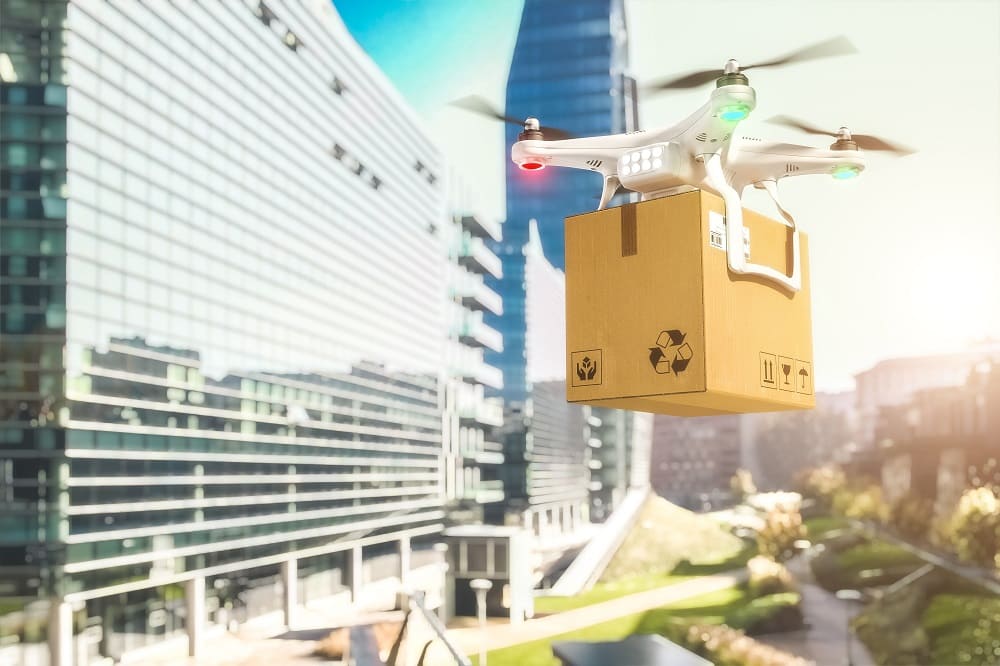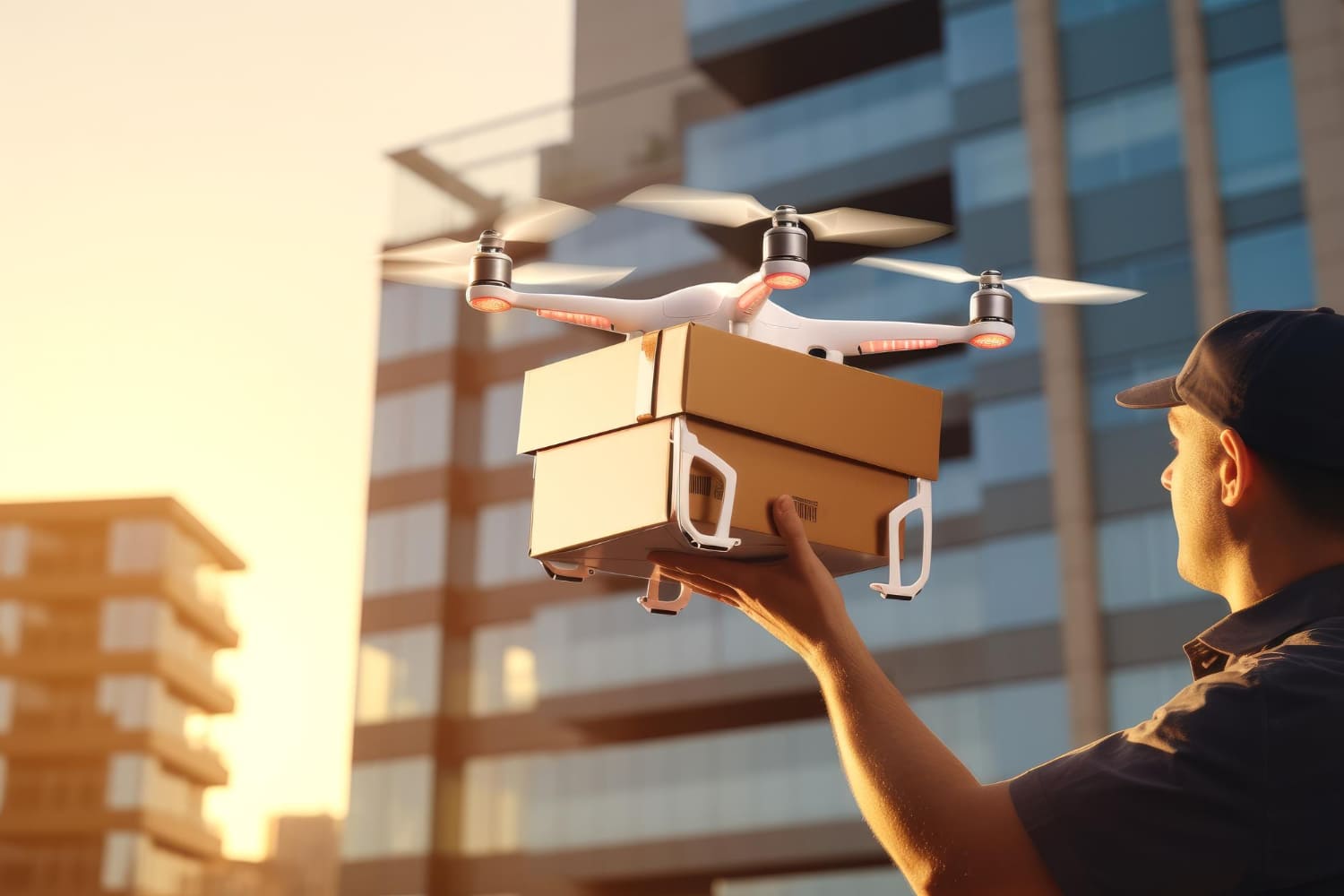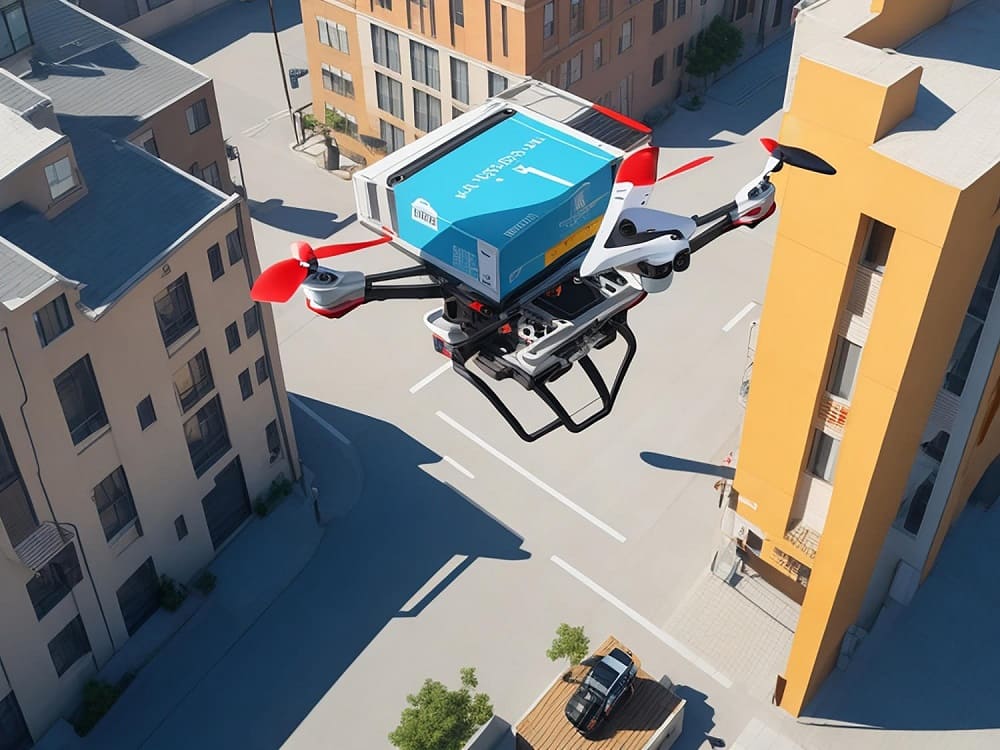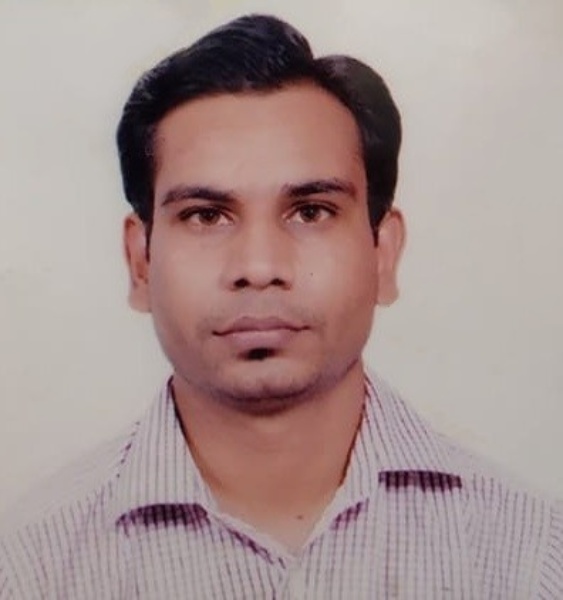
On-Demand Drone Delivery App Development: Transforming The Future Of Logistics
The landscape of logistics and delivery services has been evolving rapidly, and one of the most exciting innovations is on-demand drone delivery. The concept of using drones to transport goods quickly and efficiently has garnered significant attention in recent years. In this comprehensive blog, we will explore the world of on-demand drone delivery app development the challenges it presents, the opportunities it offers, and the steps involved in bringing this disruptive technology to life.
Facts and Figures: Drone Delivery Market Statistics
- According to the most recent data, the global drone package delivery market is projected to grow at a compound annual growth rate (CAGR) of roughly 47.8% to reach approximately $7168.8 million by 2030.
- With a 54% compound annual growth rate, the Fortune Business Insights report projects that the global drone delivery market will reach approximately $31 billion by 2028.
- According to Marketwatch.com's research, drone distribution delivery will reach a global market cap of $11 billion by 2027, growing at a compound annual growth rate of 54%.
- According to projections from Gartner, one million or even more drones could be used to assist with retail deliveries by 2026.
- By 2021 and 2026, when the forecast period ends, this amount should increase to $3.47 billion.
- Allied Market Research projects that the drone package delivery industry will grow to a value of approximately $32.1 billion.
- It is anticipated that the drone delivery market will grow to a size of approximately $1.47 billion globally.
Soar into the future with our exploration of on-demand drone delivery app development. This blog post delves into the exciting possibilities and challenges of integrating drone technology into the delivery landscape. Whether you're a tech enthusiast, entrepreneur, or logistics professional, this guide provides insights into the potential of on-demand drone delivery apps and their impact on the future of logistics.
These figures indicate that the market for drone package delivery will likely continue to grow. Someone who is thinking of starting a drone delivery business should give it a shot.
How do Drones Work?
Drones help in cost cutting by delivering individual packages safely to customers faster and at a reduced cost.

1. Take Off
After the order is placed, the procedure begins. The local business begins preparing the ordered item for shipment by packing it in their warehouse and sending it out in a package made specifically to be carried by a drone.
First, the drone takes off from the warehouse and heads toward the customer, hanging the package that was ordered.
The drones pick up and deliver orders to customers using the vertical takeoff and landing (VTOL) method.
2. Navigation
Drones must find their way to customers' locations through densely populated and obstacle-filled areas.
Drones use a variety of techniques, so there's no one right way to do this. GPS navigation is one of these that drones frequently use to find the customer's end.
You can see that cameras have been installed above the drones; these serve as the drones' eyes and their ears, respectively, thanks to SONAR and RADAR technology.
Drones become intelligent and can navigate through populated areas with the help of these parts and functions. They can identify and avoid obstacles such as trees, buildings, birds, and other drones.
3. Package Delivery
When a drone arrives at the customer's residence, it can use one of the three methods listed below to safely deliver the package:
- Fly-By
Drones buzz over the customer's property, then the package bounces down. But when a fragile item is inside the package, this mode is very dangerous. but more quickly than with other drone delivery methods. - Chord And Packet Structure
The package is not released by the drone as soon as it reaches the customer's location. It locates a safe spot on the underside first, and then it departs. The customer would designate that area, or perhaps they would place a mat bearing a QR code so the drone could recognize it. After scanning that QR code, the drone's camera determines it is a secure location to drop off. The package is released onto the mat after descending with the aid of a chord. - Complete Landing
When using this drone package release mode, the drone descends, lands at the designated spot, releases the package, and then takes off again. - Back to Base
The drone takes off and navigates back to the base after finishing the delivery task. This base serves as the warehouse for the drone shipping company, readying it for delivery the following day. The business checks the battery power again and resets the systems.

The Benefits Of On-Demand Drone Delivery
1. Speed And Efficiency
One of the most significant advantages of on-demand drone delivery is speed. Drones can bypass traffic and deliver goods quickly, reducing delivery times to minutes instead of hours.
2. Cost Savings
Drones can significantly reduce operational costs for delivery services. They don't require human drivers or extensive infrastructure, leading to potential cost savings.
3. Reduced Environmental Impact
Electric drones produce fewer emissions compared to traditional delivery vehicles, contributing to a reduction in the carbon footprint of delivery services.
4. Increased Accessibility
On-demand drone delivery can make it easier to reach remote or underserved areas, providing essential goods and services to communities that were previously challenging to access.
5. Contactless Delivery
Drone delivery will assist in achieving contactless delivery after COVID-19, which is when it is most crucial. After learning painful lessons from the pandemic, the majority of customers still abide by safety precautions and will opt for this type of package delivery.
Challenges And Considerations
1. Regulatory Hurdles
The operation of commercial drones is subject to strict regulations. Compliance with airspace rules, safety requirements, and privacy laws is a significant challenge for developers.
2. Safety Concerns
Safety is paramount in drone delivery. Ensuring that drones operate without causing harm to people, animals, or property is a top priority.
3. Privacy and Security
Drone cameras can raise concerns about privacy and data security. Striking a balance between providing efficient services and respecting individuals' privacy is a challenge.
4. Technical Challenges
Developers must overcome technical hurdles such as range limitations, battery life, and obstacle avoidance systems to create safe and reliable drones.
Components Of Drone Delivery App
- Camera
- GPS Navigation Chip
- Flight Controllers
- SONAR/RADAR Technology
- Step 1: Drones are typically equipped with low-resolution cameras that allow them to maneuver and drop packages in a location that is safe for them. In addition, it can identify and shield flying objects—like birds and other drones—from harm.In addition, drones deliver packages safely and efficiently by scanning the QR codes that customers have placed.
- Step 2: Each drone is equipped with a GPS navigation chip that helps brands track their other drones as well as recognize the customer's delivery location.
- Step 3: Thanks to their sophisticated RADAR/SONAR technology, drones can detect their surroundings and avoid collisions by projecting sound waves and returning sound waves. As you've probably noticed, most chips are fairly large, but these chips are specifically designed for drones, so they're smaller, lighter, and more compact.
- Step 4: In this case, flight controllers serve as the drones' brains, much like the CPU does for a computer. To determine a safe route to the delivery location, they process all of the input data from cameras, GPS units, and SONAR/RADAR systems. To ensure a quick and safe flight, these controllers control the thrust, yaw, pitch, and other necessary movements or actions. This part is crucial to a drone's operation and aids in its complete autonomy.
- Step 5: Unmanned aerial vehicles (UAVs) are drones that are controlled by software that allows them to fly autonomously make decisions about their flight paths and avoid obstructions.
Drone software operates in layers, with each layer carrying out distinct tasks. Together, these layers create a cluster called a stack, which functions as a framework for a solution offering to carry out top-level tasks like completing deliveries.
Features Of Drone Management Software
1. GPS Integration
GPS improves customer experience by streamlining directions and cutting down on delivery time when it's integrated with drone management software.
2. API Integration
API integration makes it easier for users to obtain the information or services they require. Additionally, API shortens the number of steps required to complete a task, improving the client experience.
3. Sensor Integration
Drone management software will become intelligent and sophisticated with the integration of sensors. It will contribute to the drone's high-tech advancement and speed up its operation and productivity, which saves money and time.
4. Audio/Live Video Integration
The software's efficiency will increase with the integration of audio and live video. Customers would enjoy witnessing the delivery of their package via air.
5. Payment Gateway Integration
When one-tap digital payment options are incorporated into the drone app development process, the software will become more intelligent and responsive, saving users time and streamlining the payment process.
6. BLE Integration
BLE technology and a Bluetooth system combined with drone software will result in low power consumption, accuracy, and quick data transfer. Labor and battery costs can be reduced for drone development companies.
7. Custom Dashboard
Users of drone software will love using the customized dashboard, which has payload integration plugins, templates, and customized widgets, among other features.
8. Integration Payloads
The payload is the maximum amount of weight that a drone can transport. The weight of all other components, such as sensors, additional cameras, or delivery items, is included but not the weight of the drone itself. As a result, its integration will enable you to add additional technology to suit your changing needs. For example, you can increase the number of sensors on your drone to process more data.
9. Connectivity
The administrator will be able to monitor unusual activity and control his dashboard using a drone controller app that has dashboard connectivity.
10. Cloud Server Storage
The drone delivery app's cloud server storage will make it easier to store all of the footage that drone cameras take while in flight. This preserves the battery life of the drone and camera so that they can travel further without having to be stored on the device itself.
11. Collision Avoidance
With this embedded feature, drones can use intelligent algorithms and AI-based workflows to detect obstacles in their path and avoid colliding with them in challenging environments.
12. HD Live Video Sharing
It would be incredible and very useful to share drone footage that is capable of streaming live HD-quality video over a private URL.

Advanced Features Of Drone Delivery App
1. In-App Wallet
Bill payment, money transfers, and adding and paying the amount while making a purchase are all made easier with drone delivery apps that have in-app wallets. It will provide users with safe, simple, and quick payment choices.
2. Live Tracking
Customers may track their packages and obtain real-time status updates by using their drone parcel tracking app once the ordered product has been picked up.
3. Discount Codes
When selecting drone delivery for their ordered items, consumers will remain engaged and benefit from the app's discount code feature.
4. Time Of Arrival
A delivery drone app's estimated time of arrival feature allows consumers to know the package's current location while it is in transit.
5. Geofencing
This software feature alerts or limits the drone about impending impediments using the GPS receivers on the device. The system's well-integrated digital airspace chat clears no-fly zones and areas with active drone limitations.
6. Accurate Landing
Using computer vision technology, this drone delivery software feature enables the drone to hover or land precisely and independently above an intelligent delivery mailbox.
7. Points of Automation
With this function, the drone management software creates automated waypoint routes that automatically exclude a no-fly zone and connect the take-off position (with the package) to the customer's location.
8. Drone Indifferent
All of the leading drone platforms, like PX4, Ardupilot, or DJI, which make it easier to manage a hybrid drone fleet, should be supported by drone delivery software.
9. Distance Communication
With the use of this capability, app users may remotely manage and operate their fleet of UAVs for package deliveries via the cloud on a variety of networks, including 5G, 4G, and LTE.
The Development Process Of Drone Delivery App
1. Market Research And Feasibility Study
Before you embark on development, conduct comprehensive market research to understand demand, competition, and feasibility in your target region.
2. Business Model And Legal Compliance
Determine your business model (B2C, B2B, or a hybrid). Ensure strict compliance with all local and national regulations, obtain necessary permits, and collaborate with legal experts.
3. Hardware And Software Selection
Carefully select the drones, software tools, and technologies needed for your project. You may need to partner with drone manufacturers or custom drone builders.
4. App Design And Development
Develop user and operator apps with essential features such as order placement, tracking, payment processing, communication, mapping, and safety features.
5. Testing And Quality Assurance
Thoroughly test your apps and drone systems to identify and address issues. Safety, reliability, and user experience should be top priorities.
6. Launch And Monitoring
Launch your service in a controlled manner, monitor operations closely, and make continuous improvements based on user feedback and data analytics.
Business Models And Revenue Streams
B2C (Business to Consumer)
Offer direct delivery services to consumers, delivering a wide range of goods, including groceries, consumer electronics, and more.
B2B (Business to Business)
Collaborate with businesses in various industries to provide efficient delivery services for their products.
Hybrid Models
Combine B2C and B2B services to diversify revenue streams and reach a wider audience.
Promotion And Marketing Strategies
1. Partnerships With Local Businesses
Form partnerships with local businesses to expand your customer base and offer exclusive deals to their customers.
2. Marketing Campaigns
Launch marketing campaigns that highlight the speed, efficiency, and environmental benefits of your drone delivery service.
3. Customer Engagement
Engage with customers through social media, email marketing, and feedback collection to build brand loyalty.
Market Leaders For Drone Delivery
1. Amazon Prime Air
In thirty minutes or less, Prime Air's tiny drones can deliver packages weighing up to five pounds. The UK, Israel, Austria, France, and the United States are where Amazon's Prime Air development centers have developed and tested the platform. In August 2020, the FAA authorized Amazon to deploy its Prime Air delivery drones to swiftly and safely deliver goods to customers. At the 2019 MARS conference, Amazon unveiled the most recent version of their Prime Air drone design. Amazon was granted patents in 2017 for its on-the-ground mobile drone fulfillment and maintenance carriers.
2. Wing
In 2012, Wing, an Alphabet company, was established. It provides a tiny drone and the OpenSky navigation system for package delivery. Wing's drone is designed to carry light packages up to 3.3 pounds in weight. The delivery drone and customers don't communicate directly. The aircraft hovers about 20 feet above the ground as it gradually lowers the tethered object to the ground. Wing has completed over 100,000 deliveries on three continents and was the first company to receive FAA Air Carrier certification. Because of the pandemic, Wing saw a significant spike in demand in 2020 from many stay-at-home customers. Collaborations with local businesses, FedEx, and Walgreens made this possible. There are four locations for Wing: Canberra and Logan City in Australia; Christiansburg, Virginia (USA); Helsinki, Finland; and both locations are in Australia.
3. Matternet
Matternet, a startup founded in 2011, provides end-to-end drone delivery solutions by utilizing its in-house M2 drone, cloud platform, and station. Companies in the logistics, e-commerce, and healthcare sectors can use Matternet's platform as a service. The Swiss aviation authorities have permitted Matternet to carry out extensive logistics operations over cities. Matternet drones can transport payloads up to two kilograms and four liters over distances of up to twenty kilometers. The in-house software platform of Matternet processes client requests plans delivery routes, and oversees, directs, and manages all of the business's operational assets.
4. Zipline
Since starting to deliver essential and life-saving goods in 2014, Zipline has made about 100,000 commercial deliveries. Zipline's headquarters are in San Francisco, while the company's distribution centers are located in the heart of each service zone. Local resources are hired and trained to supervise flight and fulfillment operations. Drones, according to Zipline, can aid in achieving its goal of giving every person on earth instant access to essential medical supplies.
5. Flytrex
Flytrex offers an unmanned drone-based end-to-end delivery service that is available to retailers, online marketplaces, restaurants, and delivery companies. Flytrex drones have a 6.2-mile range and can carry payloads up to 6.6 pounds in weight.Flytrex began as a supplier to an Israeli drone manufacturer in 2013, but rapidly developed into one of the first commercial drone operators in Reykjavik, Iceland, delivering groceries and other items. Flytrex's test programs are also located in North Dakota and North Carolina. Walmart has announced that it will begin using Flytrex drones in a test operation in Fayetteville, North Carolina, in September 2020.
6. Flirtey
Flirtey is a company that provides last-mile delivery services using drones. The company's delivery drone is a hexacopter made of carbon fiber, aluminum, and 3D-printed parts. It is a small, autonomous, and electrically powered unmanned aerial vehicle with a range of over 10 miles and a tether that lowers its cargo. It comes with built-in safety measures including low battery return to a safe location and auto-return home in the event of a lost GPS signal or communication. The business is credited with delivering the first legal parcel in the United States.
7. Wingcopter
Medical air services, drone operators, and logistical organizations are among the commercial and humanitarian drone services offered by Wingcopter. Wingcopter is located in Germany and is developing delivery solutions that may be linked to current supply chains for postal services, shops, and e-commerce platforms. Wingcopter began as a drone manufacturer but has since expanded to include drone delivery-as-a-service.
Conclusion: Pioneering the Future of Logistics
The development of an on-demand drone delivery app is a complex but promising endeavor. It has the potential to revolutionize the logistics industry, making deliveries faster, more efficient, and environmentally friendly. By understanding the challenges, adhering to regulations, and focusing on safety and privacy, you can position your drone delivery service for success in this dynamic and transformative field. As technology continues to evolve and public acceptance grows, on-demand drone delivery is set to reshape the future of logistics. Are you ready to be a part of this exciting journey?





